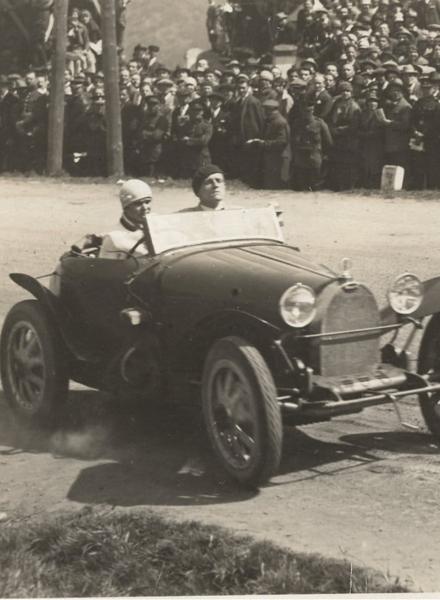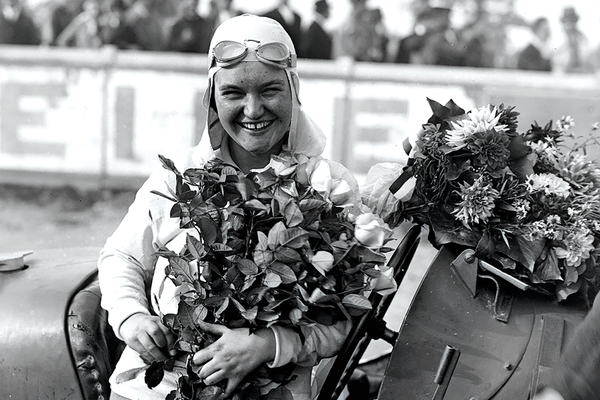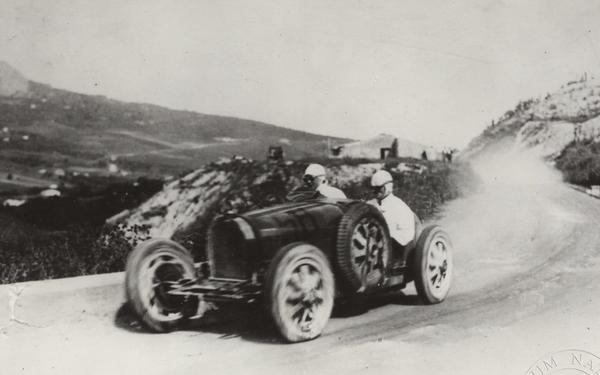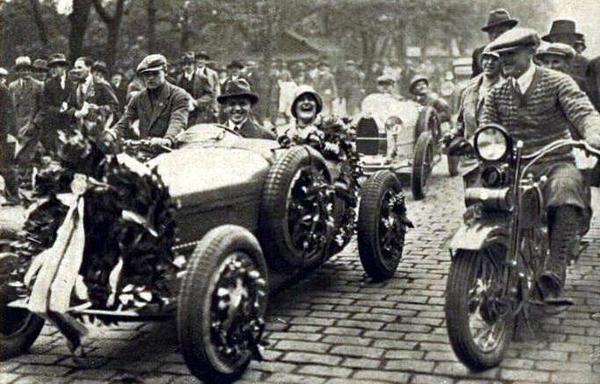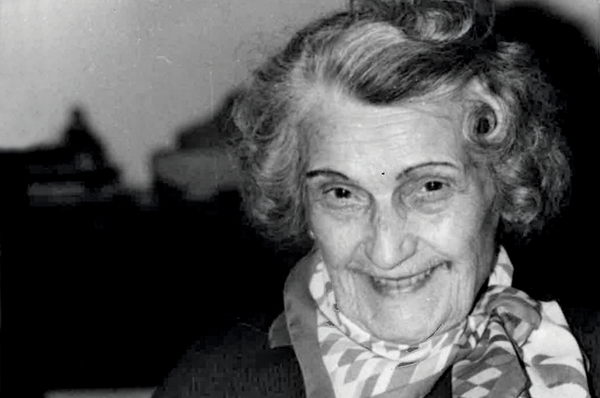November 21, 2025 Hello , In 1920s Czechoslovakia, most roads were unpaved and few women drove cars. But Eliška Junková got her license at the urging of her husband and became the fastest woman in the world. She all the male drivers, including her husband, in one of the oldest and most prestigious motoring events in Europe. Eliška won the 1926
Zbraslav-Jíloviště hillclimb becoming the first woman to win a Grand Prix auto race. Even as a young woman, Eliška had the tenacity and courage to follow through on her desire for adventure. Those qualities served her well throughout her a life of great success and fame, followed by tragedy and charting a new way forward.
Queen of the Steering Wheel
In the early days of motorsport, many drivers were pot-bellied men who just got
behind the wheel and drove off. Eliška, a small woman, had to sit on a pillow and the pedals had to be raised so her feet could reach them. Still, she became skilled
technically and was one of the first racing drivers to attack courses by walking the race ahead of time, sketching maps and taking notes of landmarks and the best line through corners.
Eliška Junková in 1926, Junek family archive
via Classic & Sports Car. Born Alžběta Pospíšilová,
November 16, 1900, in Olomouc, Moravia, Austria-Hungary Eliška Junková-Khásov liked to say she welcomed a new century. She certainly became an independent 20th Century woman, charting a course few women had taken before. Eliška was eager to see the world and at sixteen, her language skills landed her a job at the Prague Loan Bank. Her boss, Čeněk Junek, was a resilient, hardworking young man from a poor family, building a promising career in banking. He was six years her elder, but they became close, and when Čeněk moved to open a branch in Brno, Eliška went with him. She followed him for a new job in Prague, but she wasn't ready to settle down and get
married. She spent time traveling in France, Switzerland, and Gibraltar. When Eliška ended her travels and reunited with Čeněk, he had done well for himself in the banking
business and had begun to indulge in his passion for automobiles. "If he is going to be the love of my life," Eliška decided, "then
I better learn to love these damned engines." Čeněk started racing in earnest, winning the International Zbraslav–Jíloviště hillclimb in 1922, after which they
married and took their honeymoon in a Mercedes racing car. "On the drive from Prague we had only seven punctures. The Mercedes had a top
speed of 156 kilometers per hour," Eliška explained later. "But the brakes and the tyres couldn't keep up, they were bad." But Eliška had fallen in love
with sports cars and racing. She took driving lessons and qualified for a license. Čeněk asked Eliška to drive their racing car 650 kilometers to the Bugatti workshop in
Alsace in 1923. She succeeded alone, impressing Ettore Bugatti, "who did not understand how a woman could cover such a distance with his racing car alone – without a mechanic. He was so enthusiastic that he then invited me to his family," This marked the beginning of a close and long-lasting friendship.
Eliška Junková at the Zbraslav-Jíloviště race in 1927, photo: e-Sbírky, Národní muzeum, CC BY-NC-ND 4.0 DEED Eliška first rode along, as Cenek's mechanic and changing gears for him due to his war injury. Then riding mechanics were banned in Europe and
America. Cenek gave Eliška her dream car: the Bugatti Type 30 that was to become her car of choice throughout her career. She competed in her first professional
race in 1923, with Čeněk at her side. In 1924, in the Bugatti, she competed in the Lochotín-Třemošná hillclimb. When she came in first place she became a national sensation. She dressed in the same outfit each race, easily identified in her blue skirt, white blouse, helmet and glasses. Over the next two years, Eliška raced throughout Europe, sometimes competing against her husband. Fans called her the fastest woman in the world, Queen of the Steering Wheel. "She had the courage to compete against the strongest men in the toughest races of her time," Motorsport Commentator Martin Straka told Radio Prague International. "And it also took courage to stand up to the pressure from women who tried to talk her out of competing with men."
As a child Eliška was nicknamed smíšek (giggler) for her ever-present smile. The International Zbraslav-Jiloviště came round in 1926, which Čeněk had won 1922. This year he faced a fierce young competitor who would make
history.
"That's when the unbelievable happened," Eliška said. "I won against all the men. I couldn't really enjoy the victory because it was raining – and it was a bit worse in the race car. But it was the first time in the then 25-year history of motorsport
that a woman defeated all men in an international classic race."
She was the first woman in the world to win a Grand Prix event, besting her husband by 1.3
seconds. Now, Eliška turned her steering wheel toward the Targa Florio, one of the oldest, most iconic motor racing event in the world, it attracted the most skilled and
daring drivers. The Juneks raced it for the first time in 1927. The Targa Florio had been created in 1906, in Sicily. It had become both famous and feared. The course
wound through beautiful scenery, villages and mountain vistas, while presenting a legendary test of courage to both drivers and cars due to its extreme length, harsh mountain roads and literally thousands of hairpin turns.
Eliška Junková at the Targa Florio race in 1928 With Čeněk along as a passenger and mechanic, Eliška started her engine for the tough 8-hour race over the rough and often
muddy mountain roads. The race required stamina as well as speed. That year, the race consisted of five laps of the 67-mile circuit for a total of 335 miles. After a strong start, Eliška was in fourth place at the end of the first lap. A third of the way into the next lap, her steering gear broke and the car veered off the road. Luckily they weren't injured.That year she
went on to win three races, including the German Grand Prix at the new Nürburgring circuit, all the while dreaming of a second chance at Targa Florio. A full month before the race in 1928, she arrived in Palermo and practiced driving the course, multiple laps a day. She marked lamp posts, walls and trees with chalk to indicate the type of curves ahead. By race day, she knew the
course better than anyone. Another driver René Dreyfus recalled race day: "In the early laps of the race she started to scare the wits out of the other drivers - being beaten by a woman was unthinkable then - and
she was up with the leaders until the final lap." But all the practice in the world cannot make up for unforeseen rocks in the road and mechanical issues. In the second half of the final lap, the Bugatti punctured a tire, then the water pump failed. Eliška dropped back, but finished the grueling race less than nine minutes behind the leader after. "She finished fifth - a terrific showing. Nobody who was in that Targa, ever forgot that formidable Lady," said Dreyfus. She had beaten 25 top male racers on one of the hardest circuits at the time. Her return to Prague was triumphant, with thousands of people cheering her.
Junková (center) in Prague after the Targa Florio race in Sicily, 1928. Public Domain
Two months later, the couple returned to Nürburgring. This time Čeněk racing while she sat in the stands to watch. "The wait was terrible when Čeněk just didn't show up at the end of the round. And how terrible was the announcement through the megaphone, which I just didn't want to
believe. After that, I stopped racing." Čeněk Junek was thrown from his car at the Nürburgring and died from a head injury died at the age of 34. For his
wife, this changed everything. Friends tried to persuade Eliška her to race again, but even Ettore Bugatti could not convince her. The incredible career of the fastest woman in the world came to an abrupt end. But Eliška didn't stop traveling or looking for adventure. In a marketing stunt for Bugatti, she drove one of the cars over 6,000 km to India in hopes of expanding the brand's influence, then briefly took over the Bugatti business in Ceylon. She continued to work in the field as a Grand Prix organizer and interpreter, and later managed tire company Baťa’s sales department for passenger cars. She adopted her brother’s orphaned son in 1940 and when WWII ended, she remarried to motoring journalist Ladislav Khás. As long as Czechoslovakia remained under communist, she was persona non grata and banned from leaving the country. In 1966, on the 50th anniversary of the the Targa Florio she was allowed to go to Sicily for the festivities.
Even in her 90s, Eliška Junková remained a captivating personality, photo Junek Family
Archive. Eliška Junková survived communism and ensured her legacy in car racing history before dying at 93, in 1994. She has since received honors, remaining honorary president of the Autoclub of the Czech Republic, earning the Highest Merit from the Czech president in 2019, and being named Deserved Master of Sport. In 2022,
the FIVA Heritage Hall of Fame inducted her after a jury of industry experts selected her as part of its second group.
Like my article today? Forward this email to share with family and friends.
Follow me on social media
This newsletter is a reader-supported publication. To support my work, consider becoming a paid subscriber.
Read
a great book? Have a burning question? Let me know. If you know someone who might enjoy my newsletter or books, please forward this e-mail. I will never spam you or sell your email address, you can unsubscribe anytime at the link below. To find out more about my books, how I help students, teachers, librarians and writers visit my website at www.MaryCronkFarrell.com. Contact me at MaryCronkFarrell@gmail.com. Click here to subscribe to this newsletter. |
|
|


